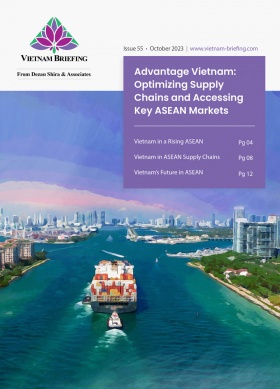Typhoon Season in Vietnam: How to Prepare Your Business
Typhoon season in Vietnam can cause significant damage to infrastructure disrupting business as usual for investors. Agriculture is one of the hardest hit, followed by logistics and IT-BPO due to incessant floods and landslides. Businesses should prepare and have business continuity plans in place to reduce business interruption and minimize financial losses during the typhoon season.
Latest typhoon update
Yagi Super Typhoon, known as Storm No. 3 in Vietnam, is expected to make landfall along Vietnam’s coast from Quang Ninh to Nam Dinh Province by September 7. The storm is forecast to reach an intensity of levels 10-12, with gusts up to level 14, and bring heavy rainfall exceeding 500mm in some areas. As of the afternoon of September 5, the Vietnam National Center for Hydro-Meteorological Forecasting reported that Yagi was located about 400km east of Hainan Island, China. Winds near the storm’s center were recorded at level 16 (184-201km/h), with gusts surpassing level 17. Yagi is expected to continue moving west-northwest at approximately 15km/h over the next 24 hours, with no significant change in intensity.
Vietnam’s vulnerability to typhoons
Vietnam’s coast along the South China Sea makes it prone to typhoons. While this geography makes the country ideal for trade and supply chains, seasonal typhoons often cause infrastructural damage, which disrupts business as usual.
In August 2020, for example, two people were killed due to tropical storm Sinlaku, which slammed into Vietnam’s northern coast, affecting the Quang Ninh, Thanh Hoa, and Nghe An provinces. In September 2021, Typhoon Conson caused landslides resulting in damaged roads and houses in Quang Ngai province; and so far this year, seven people have been killed in norther Vietnam due to flash floods and landslides. Seasonal flooding is also common in the capital Hanoi and Ho Chi Minh City due to annual rainfall, tidal floods and storm surges from typhoons.
The country experiences an average of four to six typhoons annually. The typhoon season in the southwest spans from April to September, before transitioning to the central coastline from August to November and takes the northeast region between the months of October to March.
The provinces that are most vulnerable to flooding are all located along the central coastline: Quang Binh, Thanh Hoa, Quang Tri, Thua Thien Hue, Quang Ngai, and Binh Dinh. Because the country’s typhoon warning system and protocols remain in-development, businesses in the country need to understand the full implications of the season and prepare accordingly.
How are businesses affected by typhoons?
The primary effect of typhoons on business is infrastructural damage caused by flooding. Infrastructural damage caused by high wind speeds is another concern.
Businesses in areas that have experienced infrastructural damage caused by flooding or high wind speeds are most likely to be immediately affected by employee absences due to transportation issues. Severe weather may result in canceled or delayed public transportation; however, with motorbikes being the main method of transport, poor road conditions are likely to affect all employees.
Many employees may be responsible for providing care for their family. Accordingly, employee attendance can also be affected by power cuts, telecommunication problems, or patchy emergency service provision at their residence.
Beyond employee attendance, businesses have many other concerns. On-going construction work can be exposed to damage, while supply chains can be affected by damage to roads and railways.
Businesses that serve the consumer market, or clients overseas, often struggle to maintain normal services and need to be prepared to communicate transparently about any local challenges.
All these issues can create business continuity challenges for management.
Which industries are most exposed to typhoons?
The agriculture industry is heavily impacted by flooding.
Aggressive rainfalls can prompt landslides in mountainous regions, destroying its path and flushing out low-lying areas. Landslides strip the land of natural resources while destroying crops and killing livestock. Damage to dams and reservoirs cause similar problems, which burden farmers with additional costs. This also requires extra labor to harvest new crops.
The knock-on effect for the economy can be substantial: the industry employs more than 54 million people and accounted for almost 14 percent of the country’s GDP in 2019.
Heavy rainfall and powerful floods also affect the construction industry. Flooding can destroy expensive equipment and incomplete projects. This damage extends project timelines and increases investment costs.
The logistics and IT-BPO industries are also exposed to the impact of typhoons.
When typhoons cause heavy infrastructural damage, the logistics industry is affected by delays in deliveries and services, causing bottlenecks at warehouses. This then disrupts supply chains from running smoothly.
The labor-intensive IT-BPO industry is impacted when employees cannot access safe transport to work. Meanwhile, prolonged power outages can have a serious impact on service provision for the power-hungry industry.
How can businesses prepare for typhoons?
While typhoons and their impact are unpredictable, typhoon season is an annual feature of the country’s business environment – businesses need a crisis management framework in place. Managers should seek to formulate a plan to reduce business interruption and any financial losses during a typhoon.
Every business needs to ensure important documents – like licensing or banking information – are stored in a safe place.
Businesses that are exposed to the elements, like construction, or are heavily dependent on infrastructure, like logistics, should consider the potential for weather-related project delays or disruption. This is particularly important when entering into service contracts, designing project timelines, or creating human resource handbooks and training.
Ultimately, however, every business needs a well-developed plan for severe weather conditions. This may include a list of media and government sources that provide extreme weather information, third-party risk management providers, an employee call tree, and basic supplies in the workplace, such as candles, flashlights, first aid supplies, and drinking water.
Beyond this, a business should seek to understand essential and non-essential work functions. This allows businesses to suspend non-essential work more quickly, along with other service shut-off points that need to be communicated with overseas headquarters and clients.
The impact of a typhoon is highly dependent on several factors, and managers that plan accordingly can significantly reduce their exposure to risk. Dezan Shira & Associates’ analysts note, “businesses should begin considering environmental factors when conducting market entry studies. This can include a broad understanding of regional weather patterns before identifying target regions for investment, but should also be considered when examining infrastructure in and around sites”.
(This article was last updated September 5, 2024.)
About Us
Vietnam Briefing is published by Asia Briefing, a subsidiary of Dezan Shira & Associates. We produce material for foreign investors throughout Asia, including ASEAN, China, and India. For editorial matters, contact us here and for a complimentary subscription to our products, please click here. For assistance with investments into Vietnam, please contact us at vietnam@dezshira.com or visit us at www.dezshira.com.
Dezan Shira & Associates assists foreign investors throughout Asia from offices across the world, including in Hanoi, Ho Chi Minh City, and Da Nang. We also maintain offices or have alliance partners assisting foreign investors in China, Hong Kong SAR, Dubai (UAE), Indonesia, Singapore, Philippines, Malaysia, Thailand, Bangladesh, Italy, Germany, the United States, and Australia.
- Previous Article Vietnam’s 2021-2030 National Forestry Planning: Key Objectives and Implications
- Next Article Vietnam’s Emerging Infrastructure Projects: Spotlight on Quang Nam and Phu Yen
































